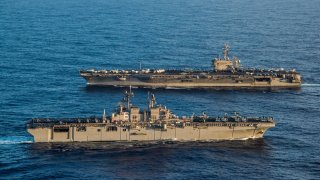Should America’s Aircraft Carriers Fear Chinese Missiles?
The age of the carrier could be ending.
If a carrier tasks forces defense’s function properly—not something to take for granted when both the attacking and defensive systems have scant operational records—then they should be able to handle a few incoming missiles. However, an attacker would seek to “saturate” the defender’s defenses by launching large volleys of the missiles all at once, and it may only take a few getting through to wreak considerable havoc.
This, however, brings us to the major critique common to all these carrier-killing tactics: they often require a high degree of coordination, operational planning and networking.
Breaking the Kill Chain
Set aside the air-defense missiles for a moment—a carrier’s first defense is that its thousand-foot-long flight deck is still nothing more than a tiny pinprick measured against the millions of square miles that make up the ocean. A tiny moving pinprick. Not just locating but also tracking a carrier across all that space relies on having a maritime observation apparatus coordinating long-distance patrol planes, submarines, over-the-horizon radars and satellites—many of which are vulnerable in turn to a carrier strike group’s aircraft and missiles.
Once that apparatus identifies a carrier’s position, the targeting data needs to make it back in a timely fashion to air, land or naval units to put them in position for an attack. This sort of “cueing” is also very important in submarine operations. In many cases, a separate platform will have to network targeting data on the carrier, as the launch platforms may be too far away to acquire them on their own radars. Of course, that targeting data may also be disrupted by electronic warfare and defensive countermeasures. Just as likely, the observers may lose track of the carrier task force’s position before elements can get into place to make the strike.
These considerations lead National Interest contributor Rob Farley to argue that China and Russia lack adequate the maritime intelligence assets and operational experience to mount a well-coordinated maritime search-and-destroy campaign against a carrier task force, even if they possess armaments that could theoretically prove effective against one.
The Operational Track Record—Such As It Is
It’s important to stress that nobody really knows how effective both the offensive and defensive naval technologies will prove against each other, as there have fortunately been no large-scale naval wars since World War II.
However, the smaller-scale naval conflicts that have occurred in the Persian Gulf, Arabian Sea and the South Atlantic all suggest long-range antiship missiles pose a substantial threat.
Consider the two British ships sunk by air-launched Exocet missiles in the Falkland War, with a third damaged by a ground-launched weapon. The first attack was not detected until seconds before the moment of impact. Argentina’s possession of just a few of the missiles nearly led London to dispatch a suicidal commando raid on Argentine soil to negate the threat.
During the same conflict, an Argentine diesel-electric submarine twice managed to launch torpedo attacks on British vessels without being detected—though, fortunately for the Royal Navy, the torpedoes all malfunctioned! Meanwhile, Argentina’s own carrier did not participate in the conflict due to the threat posed by British submarines, one of which had sunk cruiser General Belgrano.
On the other hand, antiship missiles liberally employed during the Iran-Iraq War generally failed to sink large tanker vessels—which may imply that supercarriers will also prove similarly resilient.
Obviously, these decades-old incidents should not be over-extrapolated into applying to current technology—but their lessons shouldn’t be dismissed out of hand.
One should also recall how many navies continued to invest in battleships in between the world wars, skeptical that then-new aircraft carriers could seriously challenge them. Surely, early carrier-based aircraft must not have seemed nearly as dependable as the sixteen-inch guns on a battleship turret. But those primitive warplanes and the operational doctrine for their use matured to the point where their ability to search for and destroy targets across hundreds of miles rendered the battleship obsolete.
Actual combat in World War II proved revelatory. In the December 7 raid on Pearl Harbor, Japanese warplanes sank three U.S. battleships and severely damaged several more. Shortly afterward, land-based bombers sank the British battleship Prince of Wales and the battlecruiser Repulse in a few of frenetic hours of action. To cap it off, the subsequent decisive naval battles of the Coral Sea and Midway were fought entirely by carrier air strikes and submarine attacks. It took these brutal encounters with reality to finally sweep away many navies’ long-held devotion to a weapon system that no longer provided results commensurate with the expense of building them.
Today’s supercarriers will likely serve on for decades. However, the new threats arrayed against them, combined with the limited range of the current generation of carrier-based aircraft, suggest they may prove too vulnerable to operate within striking distance of near-peer opponents.
It would make sense to plan future naval strategy around these new adversary capabilities, rather than simply doubling down on the supercarrier model because it has worked so far in permissive environments. Solutions that have been suggested to meet the new challenges posed by operating in littoral waters include using long-range carrier-based drones that will allow carriers to operate further afield from dangerous coastlines, relying on stealthy submarines to deliver cruise-missile attacks and distributing firepower across a larger fleet of individually less expensive ships. Above all, planners should seriously consider whether supercarriers loaded with relatively short-range warplanes remain a survivable and cost-efficient linchpin of U.S. naval strategy.
Sébastien Roblin holds a master’s degree in conflict resolution from Georgetown University and served as a university instructor for the Peace Corps in China. He has also worked in education, editing and refugee resettlement in France and the United States. He currently writes on security and military history for War Is Boring. This first appeared in August 2017 and is being reposted due to reader interest.
Image: Flickr.

